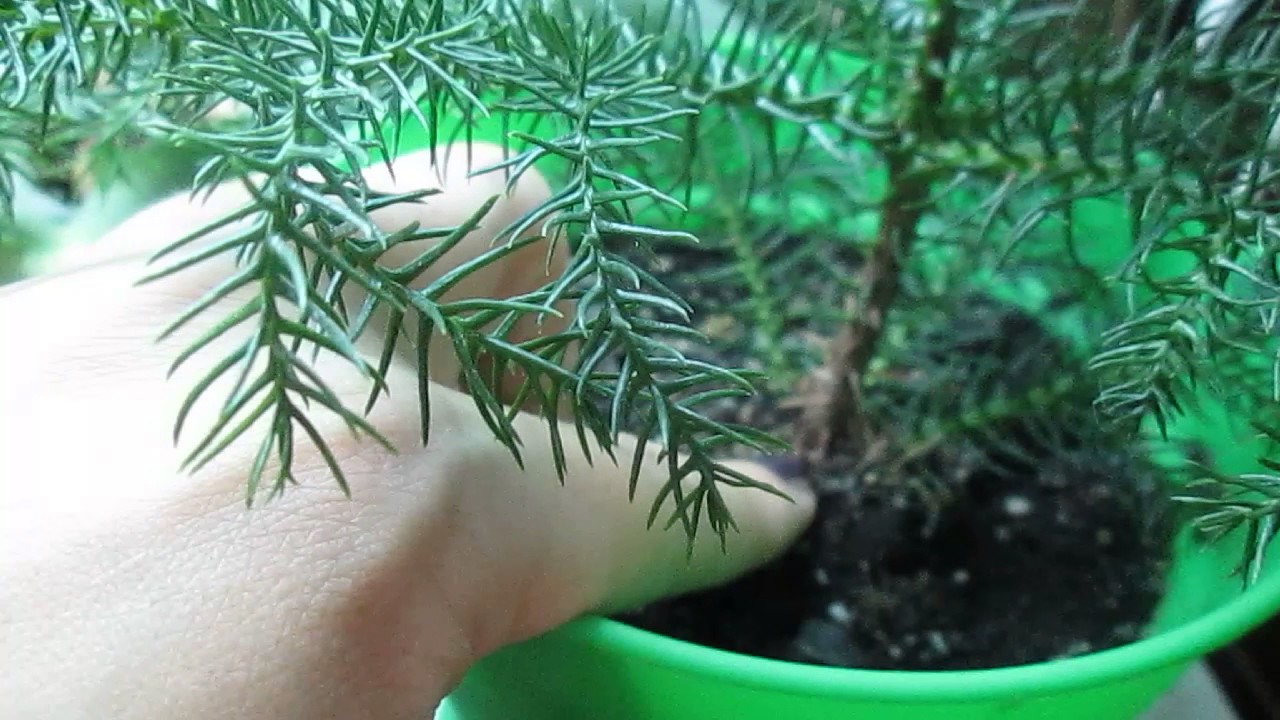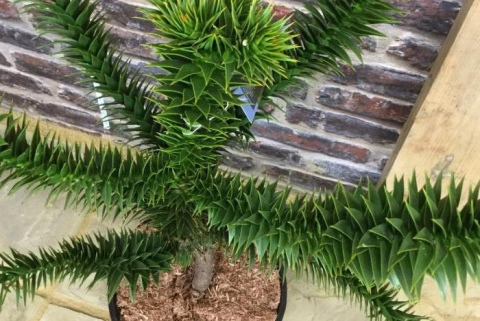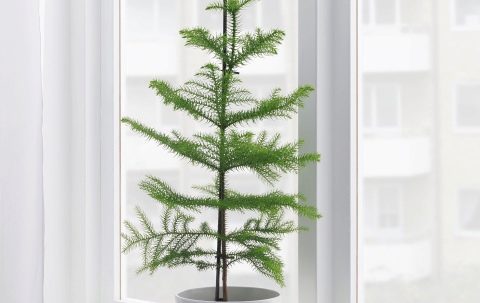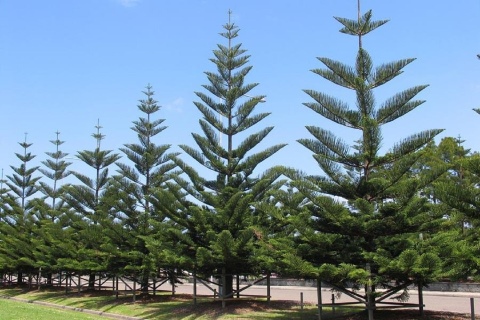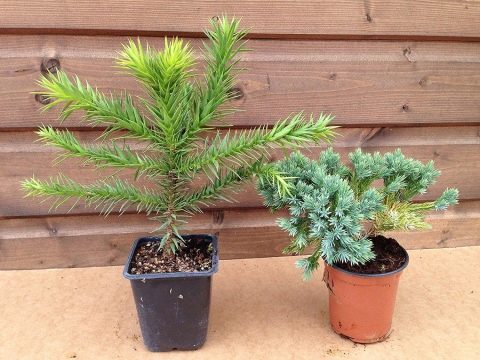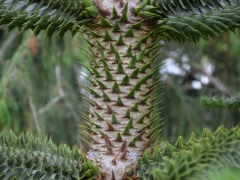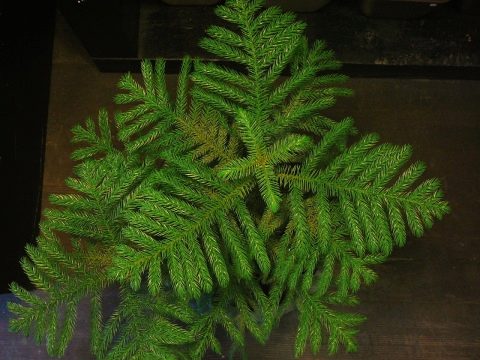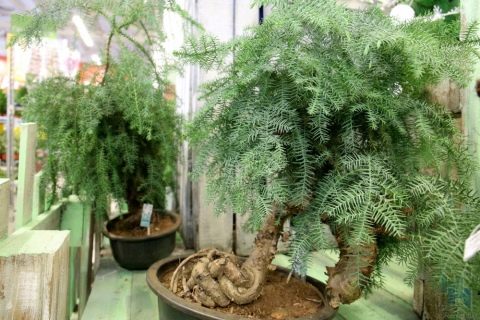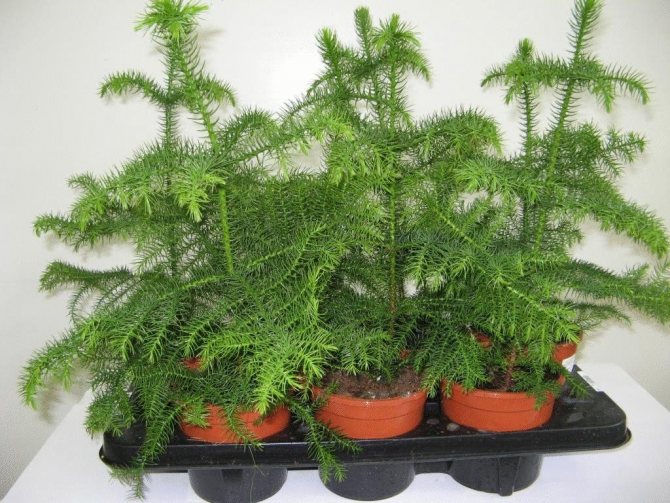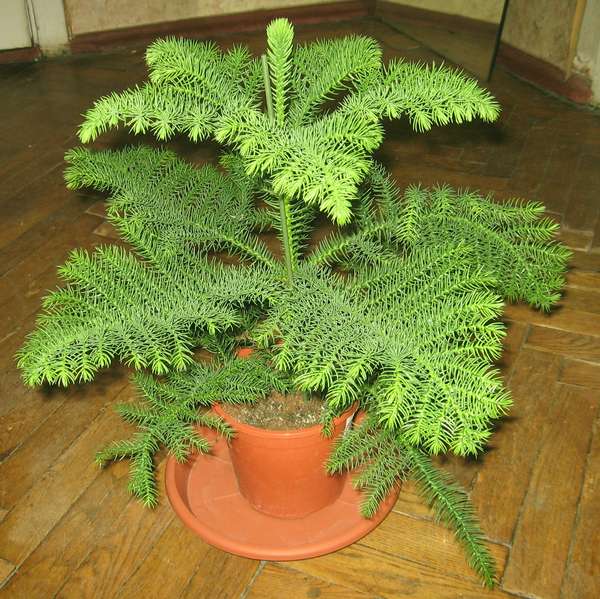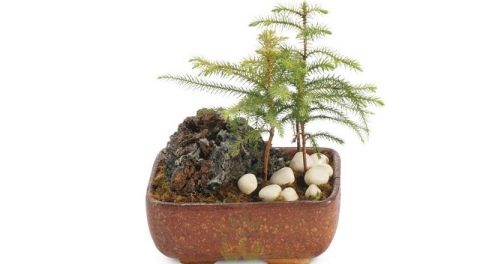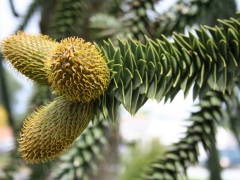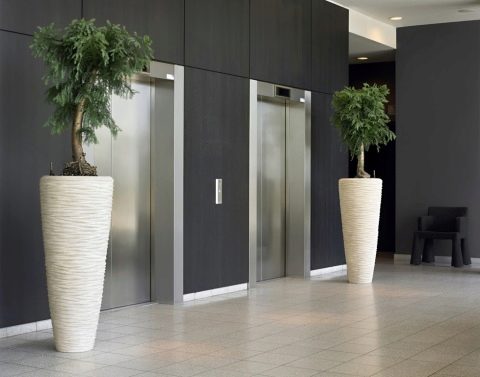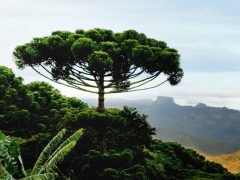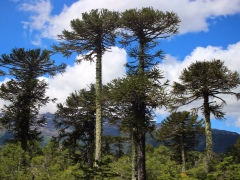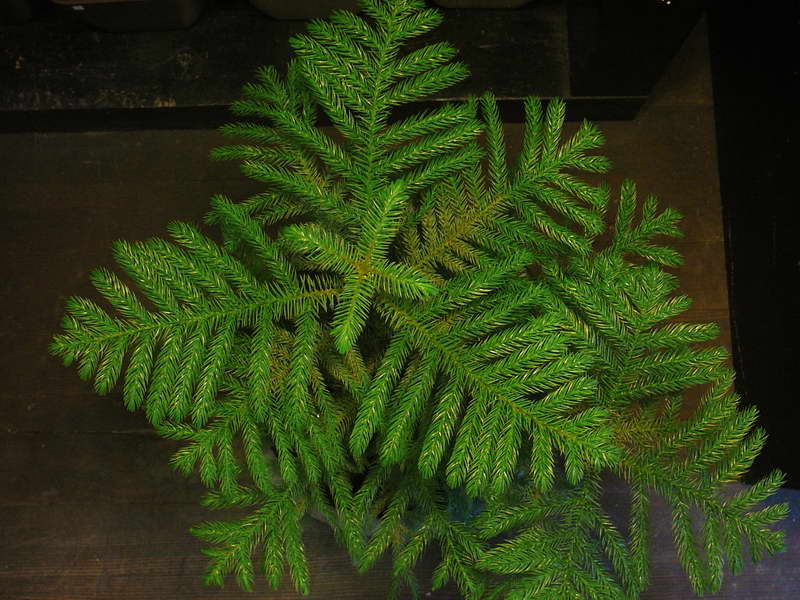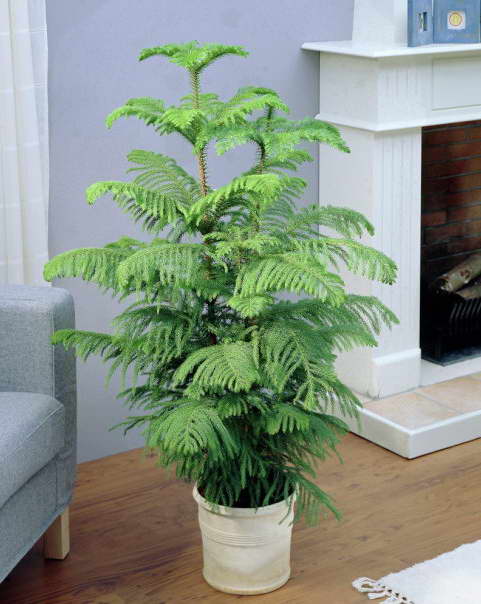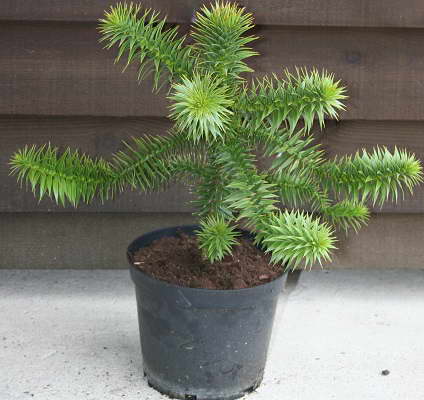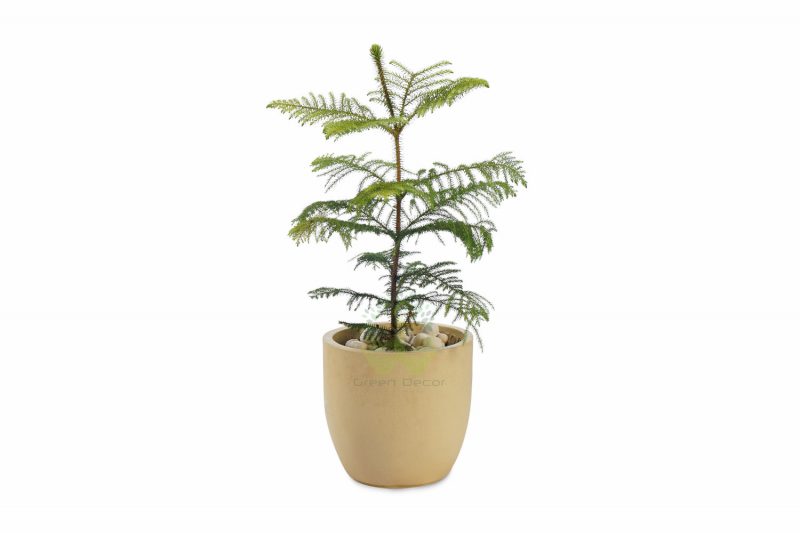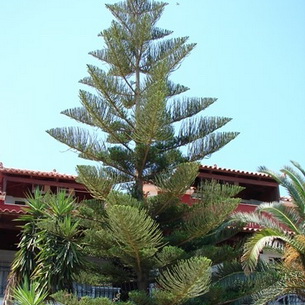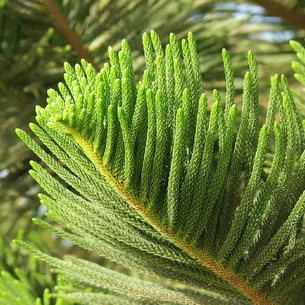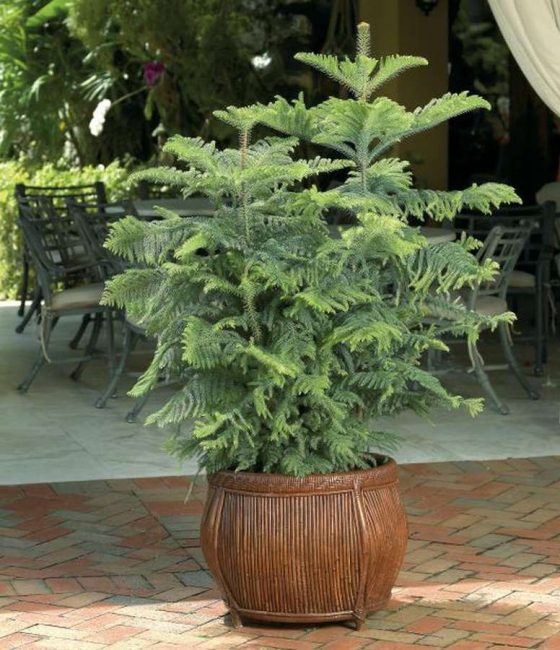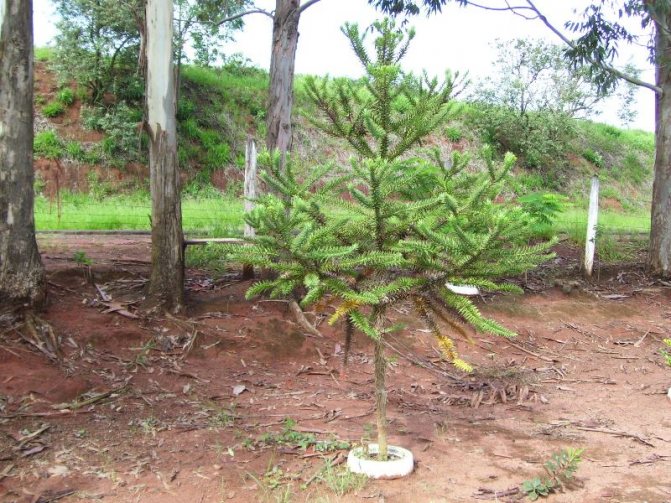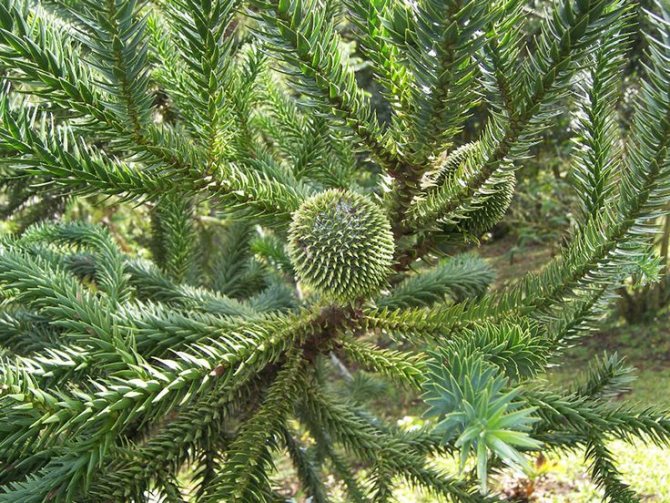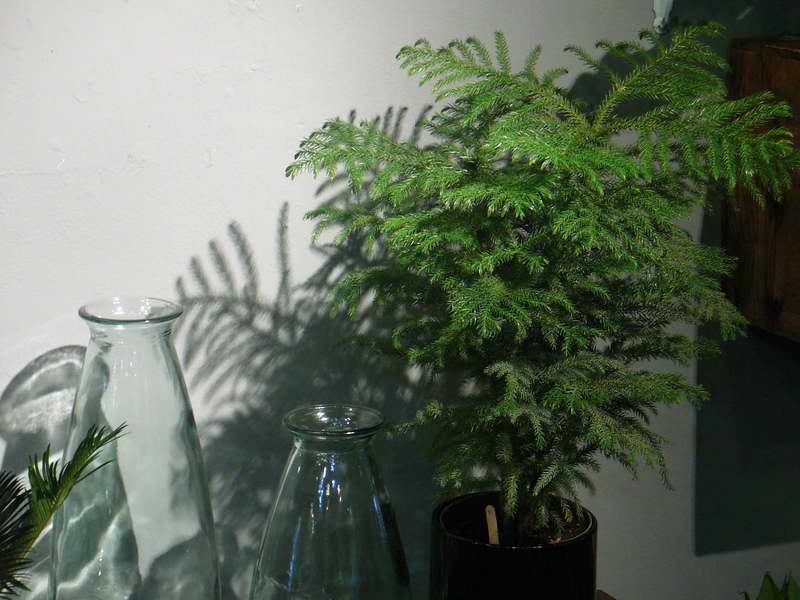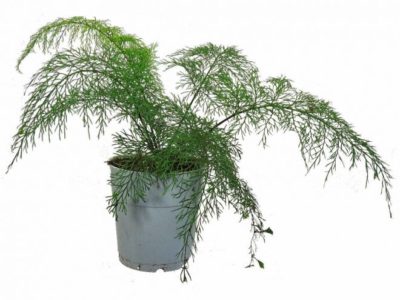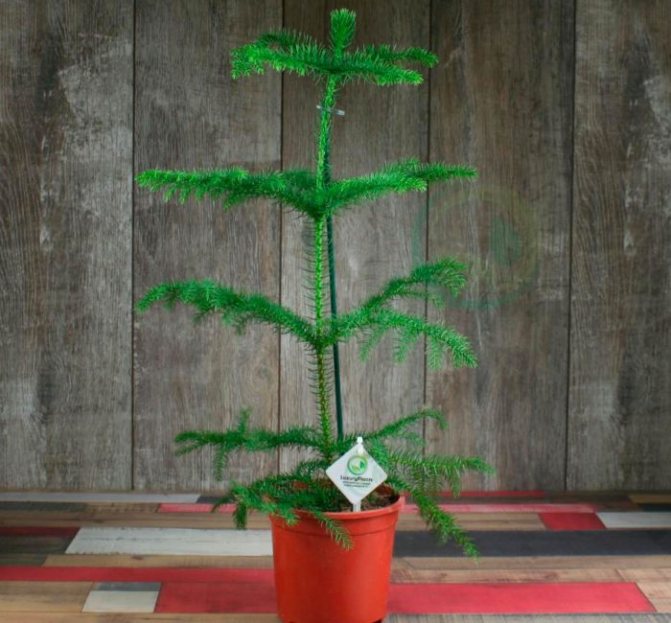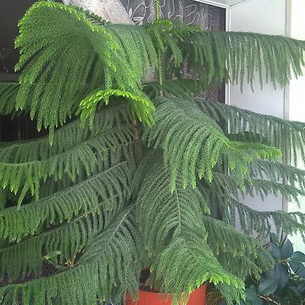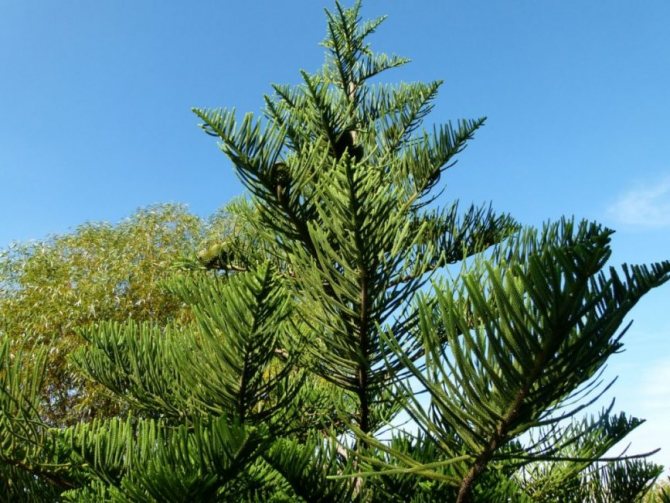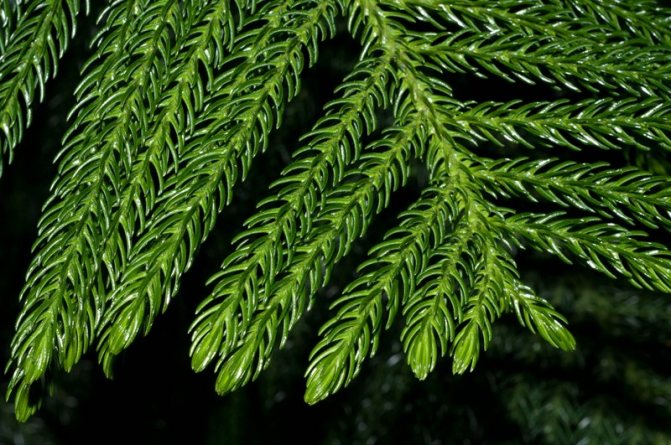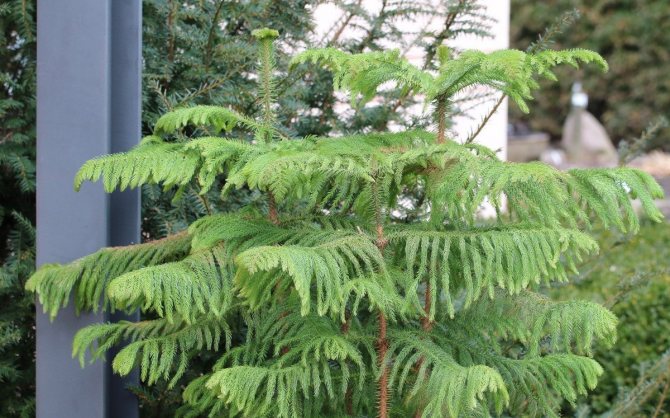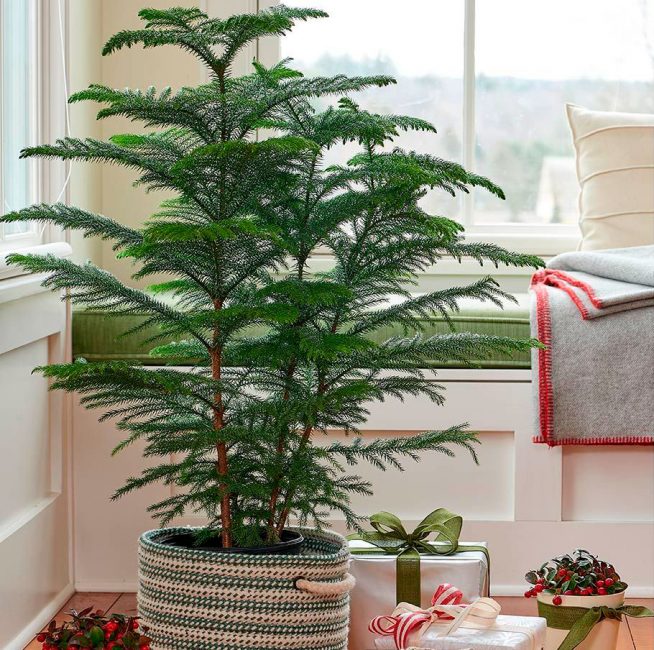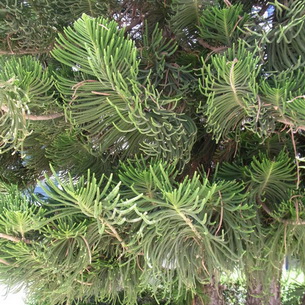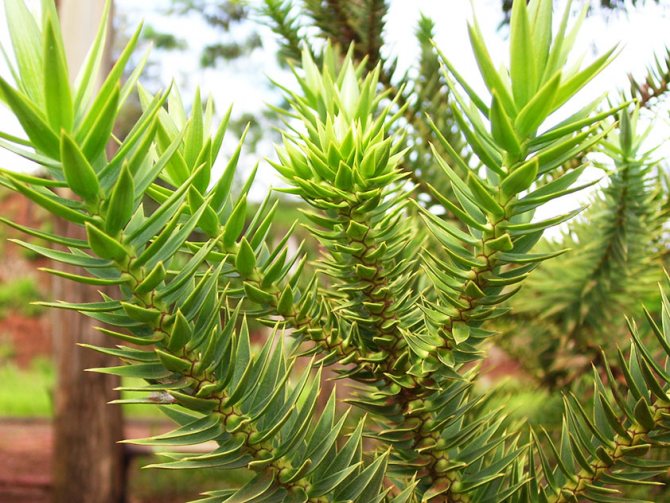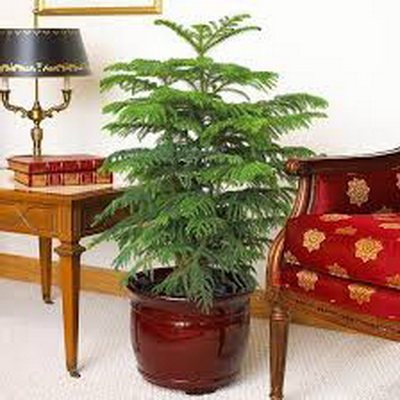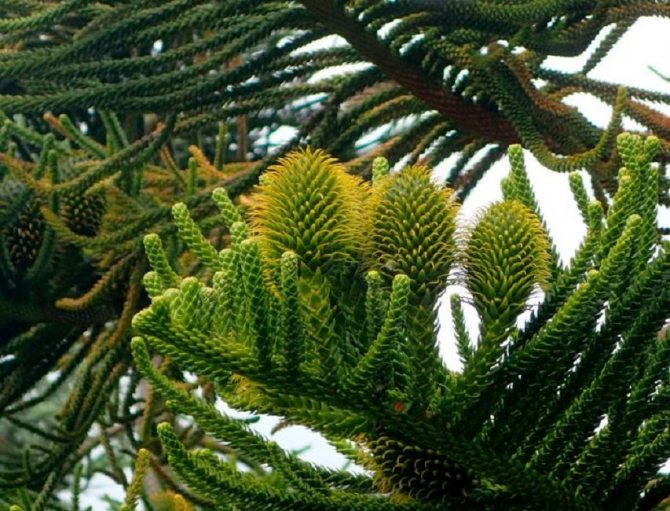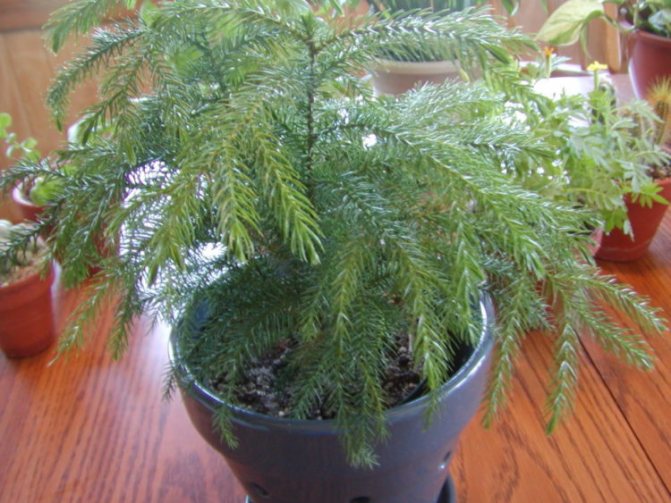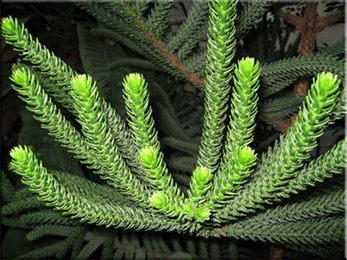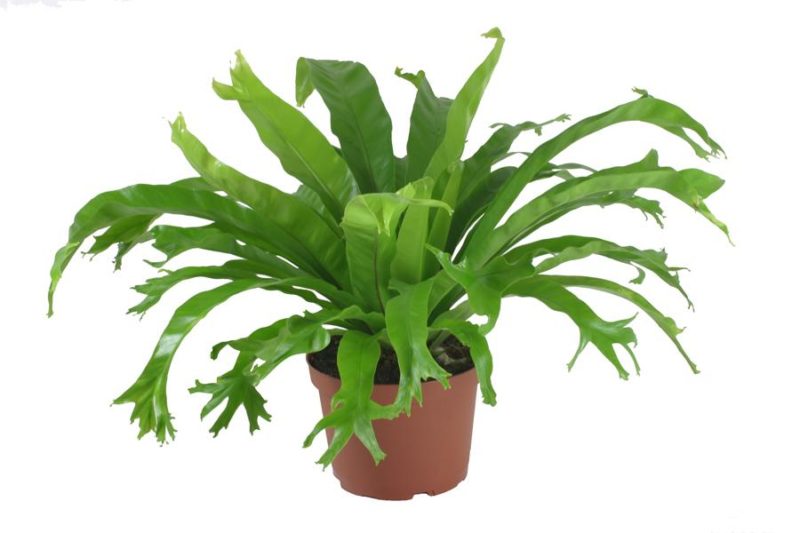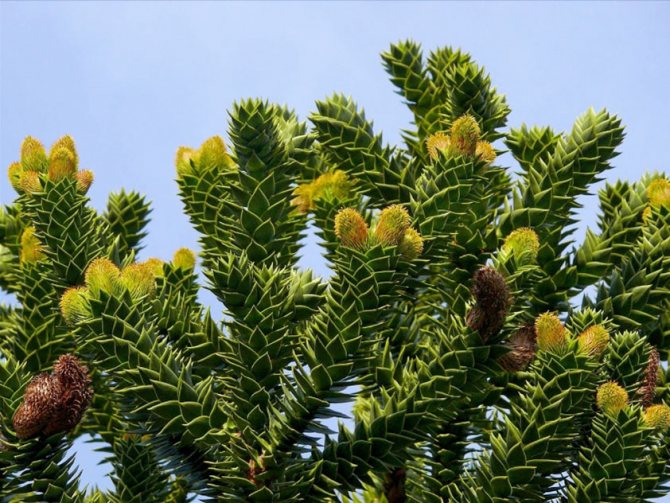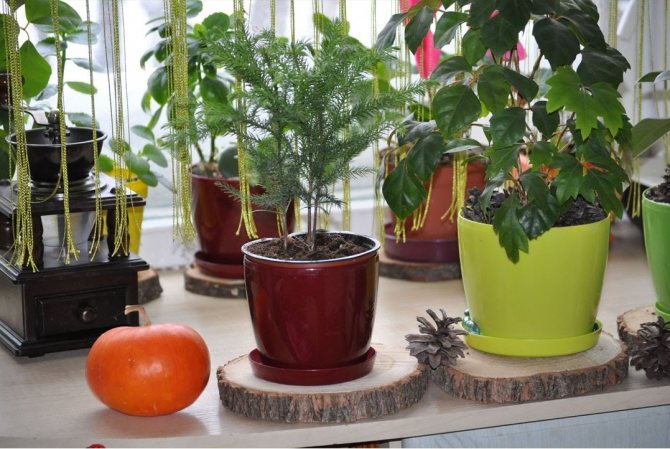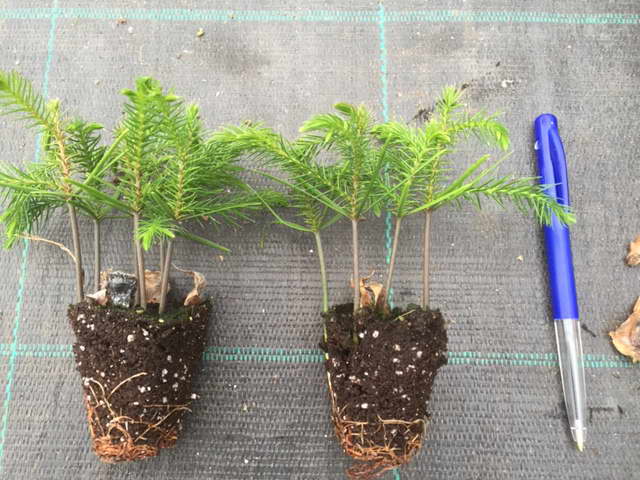3.Species of araucaria:
3.1. Chilean araucaria - Araucaria araucana
A native of Chile and Argentina, has the highest frost resistance. A. Chilean is the largest representative of the genus and can reach a height of 60 m. The tree forms a beautiful, regular pyramidal crown. In mature trees, the lower part of the trunk is bare and green branches remain only at the top of the plant, forming a kind of umbrella. The seeds of this plant are edible and resemble pine nuts.

3.2 Araucaria bidwillii - Araucaria bidwillii
A distinctive feature of this species is the dark brown or even almost black, flaking bark. Araucaria Bidville grows up to 45 m in its natural environment and has a domed crown.
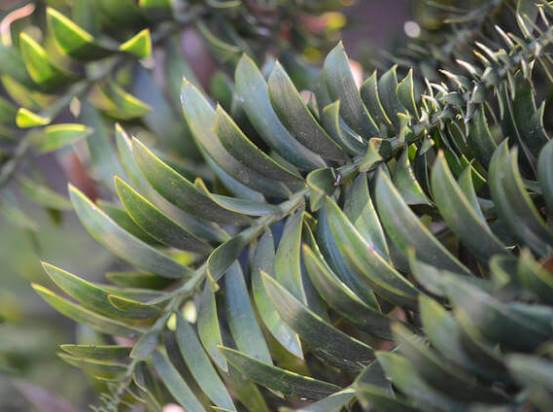
3.3.Araucaria heterophylla or Araucaria heterophylla - Araucaria heterophylla
A fast growing coniferous tree is probably the most attractive species. Forms a symmetrical pyramidal crown. Young leaves - needles have an elongated, oblong shape. In mature trees, the leaves take the form of triangular scales that tightly cover the branches. Thanks to these features, the araucaria received the name variegated.
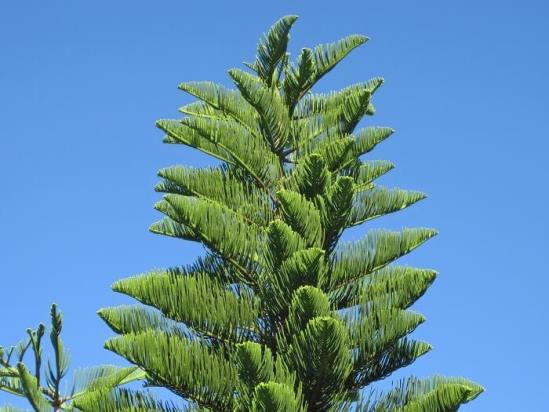
3.4 Araucaria high - Araucaria excelsa
Very airy, as if lacy, decorative deciduous plants of a symmetrical, pyramidal shape of the crown. Under natural conditions, it grows up to 65 m in height, and the trunk reaches a diameter of 3 m. When grown indoors, the height often does not exceed 2 m, and annually the plants add about 15 cm in height. An interesting feature of the plants is that the branches are arranged in tiers on the trunk. Leaves are green, long, very thin, needle-like. During the flowering period, the plant forms male cones about 5 cm long and female cones, larger, from 10 to 12 cm long. The variety is often grown at home.

3.5. Brazilian or narrow-leaved araucaria - Araucaria angustifolia
In its natural environment, narrow-leaved araucaria grows into a large tree reaching 40 m. With age, the lower part of the trunk becomes bare, and a lush green cap forms in the upper part, and therefore the plant looks like a pine tree. The branches of the collected whorls are 4 - 8 pieces. Leaves are rather thick, tough, green, oblong triangular, 3 to 6 cm long, very densely cover the stems of plants. Plants are dioecious - that is, male and female cones form on different specimens. Male cones are small in size - they reach a length of 6 cm. Female cones mature within one and a half years after pollination, and reach a length of 18 - 25 cm. Female cones are round, green, covered with symmetrical scales. The seeds of the plant are edible and taste like a pine nut and are used as food by the people of southern Brazil.
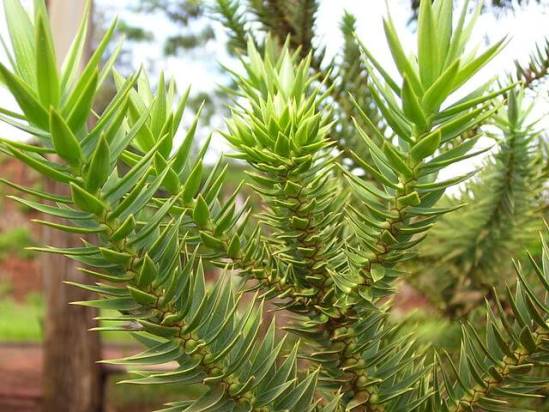
3.6. Araucaria Cunningham - Araucaria cunninghamii
A large evergreen tree with a height of 45 to 60 m, growing very slowly. The branches are collected in tiers in whorls of 4 - 7 raised. Leaves abundantly cover thin branches in a spiral, oblong triangular, about 1 cm long, green, tough, with very prickly tips. Some plants form only male cones 2 to 5 cm long, while others form only female cones up to 10 cm long.

3.7. Araucaria columnar or Cook - Araucaria columnaris
In nature, these are evergreen trees with a pyramidal crown up to 60 cm high. The branches are horizontal, collected in longline whorls around the trunk. Thin shoots are covered with spirally arranged, small, green, triangular leaves 4 to 7 mm long. The leaves are often close to the branches. Male cones are cylindrical in shape and reach lengths from 5 to 10 cm. Female cones are larger - from 10 to 15 cm.
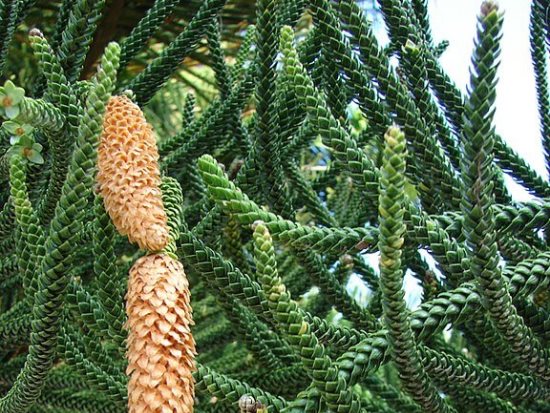
You may also be interested in:
Care after purchase
After purchasing, the needles must be rinsed from dust under a water tap.
For growth, you should choose well-lit corners without direct sunlight rays.
Do not select areas close to central heating or heaters.
Arucaria of Chile is ruined by a debilitating heat. The needles grow well in botanical gardens, front gardens and outdoor balconies.
Watering
Watering should be carried out with settled water at room temperature. The domestic inhabitant prefers frequent watering as the soil dries up. The pine loves constant spraying from a sprayer.
Such procedures do not allow the flower to dry out, while maintaining the original evergreen color. In winter, watering and spraying times should be reduced to a minimum.
Bloom
The tree is a dioecious evergreen. Has male and female inflorescences. Previously, monoecious plants were sometimes found.
But after the lapse of time, the pine changed its floor.
The female bumps are very high. They resemble a spherical shape. The diameter of the buds can vary from 5 to 30 centimeters. They contain edible healthy seeds in an amount of 70 to 250 pieces.
The male cones are at the very top of the tree. They are much smaller in size than female cones. They reach no more than 12 centimeters in diameter. They are very narrow, elongated, cylindrical in size.
Crown formation
The crown of a young tree is pyramidal, very wide. The lower branches are on the soil. After the expiration of time, the tree begins to "molt" and the stems fall off. The side branches are in whorls. They can be elongated and extended.
The crown of adult plants is flat in the form of an umbrella. It is located only at the top of the trunk. The stems are covered with small, thorny leaves. They have a rough leathery texture. The leaves are arranged spirally. They completely cover the stems.
On palpation, the leaves are rough, prickly of a dark emerald hue. The bark of the trunk is fissured, wide, longitudinal, resinous.
Soil, soil
The tree needs a substrate, mixed in equal proportions with peat, sand, turf and leafy soil.
For Araucaria Chilean, coniferous soil should be added to the soil. In such soil, the pine takes root well, actively grows and develops evenly.
Planting and transplanting
Planting or transplanting a plant should be done in March-April or June. Only wide and highly overgrown specimens require transplantation. Near such trees, the soil is braided by the root system. This fact is due to the fact that the needles negatively tolerate transplantation.
For the procedure, you must choose wide containers. Small pots will prevent the tree from developing properly and actively. Adult specimens are transplanted no more than four times a year.
Young trees can grow for more than five years without outside human intervention.
Reproduction
The plant propagates by planting seeds and dividing cuttings. For cuttings, strong shoots are cut. They are divided into small pieces no more than 15 centimeters long.
Each cutting should have at least 15-20 green needles. The stalk is planted in moist soil and the temperature factors are carefully monitored.
It is best to land at an angle. The deepening should not exceed two centimeters. Seed planting is done in early spring. The seeds are sown in prepared soil and thoroughly moistened. The first shoots should appear in three months.
Growing
Araucaria Chilean requires systematic care. The plant loves bright rooms with excellent ventilation. The containers are allowed to be taken out into the front garden or onto the balcony. Direct sunlight should not be allowed.
The flower is very fond of the shade. Requires temperatures above 12 ° C. Otherwise, the needles of the flower wither and fall off.
Grows poorly in pernicious heat. Requires good moisture and systematic watering.
Temperature
Araucaria Chilean does not take root well indoors. The plant definitely needs fresh air. The best temperature in winter should not drop below 10 ° C. But it should not exceed the 15 ° C mark.
In spring, the plant is comfortable at a temperature of 19 ° C. The needles do not tolerate heat above 22 ° C.Direct exposure to the sun should be avoided.
The tree loves diffused light. The presence of lighting should be on both sides. If the tree does not grow in a greenhouse, then the pine is turned 90 ° every week.
Why are the branches of araucaria dry and what to do
The main a sign of improper care behind the tree is the condition of its crown and branches. If they turn yellow and dry, then the plant has been attacked by pests or sick.
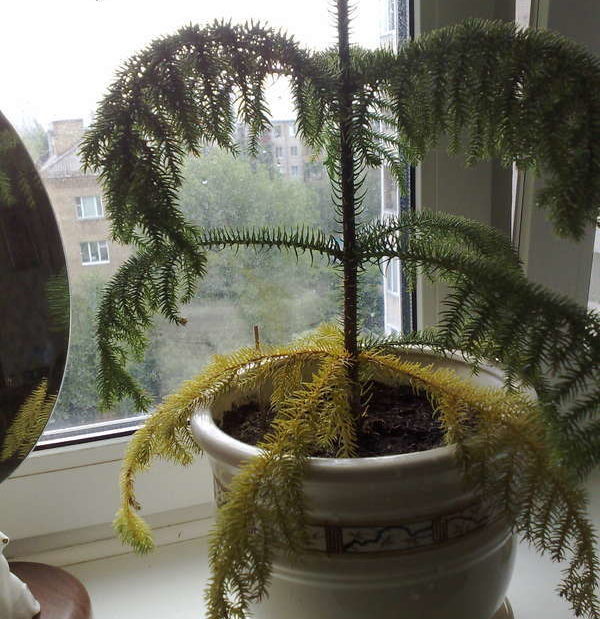 Yellowing of branches
Yellowing of branches
Pests and methods of control
Compared to other ornamental greenery, araucaria is very rarely attacked by insects that can damage it, but such cases do happen. The tree may be damaged by such pests:
- Mealybug - a sign of its appearance will be white lumps on the branches of a tree. In order to destroy the pest, you can use spraying with a solution of alcohol, laundry soap and water, and also treat the tree with special poisons at least three times with an interval of 10 days.
- Root beetle - its appearance is evidenced by the dried lower branches of the spruce. In order to get rid of the pest, you need to treat the soil with an insecticide solution.
- Aphids appear on the crown of a tree in the form of pineal growths, which grow rather quickly and the plant dries up. For disposal, insecticides are well suited, for example Mospilan, Calypso.
- The speckled moth leads to the death of the tops of the cuttings, and the plant acquires the brown color of the branches. It is necessary to treat the tree twice with special agents containing pyrethroids, the interval between such measures is 7-8 days.
- Pine loach can be noticed by the abnormal curvature of the shoots and the drying of young twigs. It is imperative to remove the affected parts of the spruce and treat it with special chemicals.
When a pest is recognized at an early stage of its development on spruce, the process of extermination is much easier, and the appearance of the greenery eventually quickly returns to normal.
Diseases and treatment
Improper plant care can lead to the development of diseases. Araucaria is characterized by the following types of diseases:
- drying and yellowing of the shoots is associated with a lack of moisture, you should bathe the flower more often;
- a curvature of the trunk indicates improper lighting. It is necessary to change the place of growth of the tree or turn it over more often;
- growth retardation occurs with an excess of potassium.
- drooping branches indicate excess moisture. Reduce the amount of water used when wetting the soil;
- thin and sluggish young shoots indicate that the greenery lacks nutrients. You should increase the amount of top dressing or change the fertilizer to a better one.
Indoor spruce has a high resistance to various diseases of ornamental greenery, but nevertheless, improperly organized care can harm the plant.
 You may be interested in:
You may be interested in:
Chlorophytum Curly - home care and reproduction Novice flower growers want to find useful and easy-to-use ornamental plants for themselves. Excellent ... Read more ...
Description of the plant
Unhurried growth can show araucaria to this world for a very long time. The fossilized finds of relatives of the araucaria are estimated to be up to 90 million years old, making the araucariacea family one of the oldest tree families in the world.
Chilean araucaria forms a crust up to 14 centimeters thick, which allows it to grow even after a volcanic eruption - this crust makes up 25% of the stem volume.
It is a symmetrical cone-shaped tree that grows up to 60 m in height and gets its general name from the outer layer of bark, which forms scaly horizontal hoops. The branches are curled and the leaves are very thin and pointed. Due to its adaptability to various conditions, it is a recognized commercial tree, which cannot be said about larch.
- Araucaria male and female cones are usually found on the same tree, while male cones form a dense cluster of cylindrical spines.
- Trees are typically 22-27 years old before they can produce male (pollen) cones, although six-year-olds have premature pollen cones.
- Female (seed) cones are round and found at the top of the tree; they have been observed in individuals at the age of six years, but the more common age at which the first seed cones appear is about 10–12 years.
- The seeds are released in a conical shape as the mature female buds decay, which tends to occur between November and February.
- Female buds are brown at maturity and are about 8-10 cm in diameter. Placing these buds close to the top of the tree allows the seeds to be scattered by a strong enough wind to displace them a significant distance from their parent.

The spread of the tree usually comes from seed, but cuttings are also possible. Seedlings should be transferred to pots after 12 months for further growth and can be planted when the seedlings are two years old.
Regular watering is essential for the first two years in the soil, and potting mix can also be beneficial in the early stages of development. Once a tree is properly planted, it becomes quite resilient and continues to grow slowly, provided it receives enough moisture.
Cuttings can also be used, but this method is less common and relatively complex. If cuttings are used, they should be taken from vertically growing shoots closer to the tops of the trees.

Araucaria is a very attractive tree, especially when planted in solid wood, as it lends a gorgeous look to any landscape. They are limited in space as they are large trees and must be planted in subtropical climates for best results.
Chilean araucaria is an evergreen tree that can form a trunk diameter of up to 2 meters. Araucaria takes a long time to do this, as it grows very slowly, which does not harm, since the impressive tree can grow up to 2000 years.
Spread of araucaria
Araucaria is a flexible tree that can grow in a variety of soils if the annual rainfall exceeds 70 centimeters. As a result, the tree is found in rainforest and tropical rainforest edges along the east coast of Australia from the McLay River in New South Wales to the very north of the Cape York Peninsula.
Care rules
- Lighting. Araucaria belongs to light-loving plants, but at the same time it should be protected from direct sunlight. When growing in an apartment, you should constantly turn so that all parts of the plant receive enough sunlight.
- Temperature and humidity. The optimum temperature is + 16-18 ° C. In winter, indoor araucaria needs coolness (the temperature should not be higher than + 12 ° C). Air humidity should be above average.
- Watering. Watering araucaria is desirable with warm and very soft water. Watering should be done regularly so that the earthy clod does not dry out by more than a quarter.
- Top dressing. From April to October, fertilizers should be applied to the soil. The amount of calcium in fertilizers should be minimal, since an excessive amount of it leads to a slowdown in plant growth.
general description
Araucaria is a coniferous, slow-growing plant that loses its decorative properties when it reaches a certain height. The length of the needles can reach 13 mm, which, depending on the season, can change shade from bright green in spring to dark green in winter. The flower is considered the only coniferous plant.
Planting the araucaria in a small pot helps to slow down its rapid growth, as the flower can be as long as the ceiling.
Dropping needles is considered a natural phenomenon, to maintain their shape it is recommended to cut them off, like ugly shoots. In order to protect against fungus, it is recommended to sprinkle the substrate with sulfur.
Homeland of the plant
The name comes from the name of the Chilean province of Arauco, the origin of which is associated, in turn, with one of the Indian tribes. Araucaria has existed on earth for millions of years, it appeared long before the dinosaurs, and now the number of this species is declining.
If in the era before the dinosaurs it grew almost everywhere, now the plant is found only in the Southern Hemisphere (on the South American, Australian continents, in Polynesia).
How does it multiply?
Mostly Araucaria is propagated by cuttings, but you can try to grow a Christmas tree from seeds - however, this will take a long time and require some patience.

Cuttings
Cutting, unlike planting seeds, is carried out in July, and not in spring:
- for planting, young cuttings are taken from the tops of the crown,
- the cut cutting is dried for about a day, then the lower part is cleaned of resin, wiped with ash or fine coal,
- into the prepared mixture of sand and peat, well moistened, cuttings are planted, then they are covered with a film (you can use a jar),
- seedlings must be watered daily, sprayed, removed the film for ventilation and oxygen access,
- do not allow low temperatures during the rooting period - ideal for future Christmas trees 25-26 degrees.
At the end of October, the cuttings will acquire an extensive root system and can be transplanted into separate pots.
Seeds
The germination and further survival rate of seeds is poor. For planting, it is recommended to take fresh, freshly harvested seeds. Even after storage for two to three weeks, sprouts may not appear, since the seeds will lose germination:
- seeds are sown in very moist soil and must be covered with a layer of moss on top, which is constantly moistened,
- the temperature in the room where the pot is standing should not fall below 20 degrees and rise above 26,
- as soon as the seedlings hatch, they need to be removed from a sunny place,
- the grown bushes are thinned out - leaving a distance of at least 10 cm between shoots, then each sprout is transplanted into a separate pot.
In the future, care for small plants is carried out in the same way as for adults.
Diseases and pests
In general, araucaria has good immunity and rarely gets sick. Many ailments are often the result of improper care, and if you do not take measures to correct the situation, the plant may die. Below are a number of the most common diseases, as well as the reasons that led to their occurrence.
So, if a tree dries up and leaves or needles fall from it, then the matter is most likely in too dry air. To correct the situation, it is recommended to spray the plant more often or put a humidifier in the room. In addition, in the autumn-winter period, the tree should be kept away from heating radiators and other heat sources.
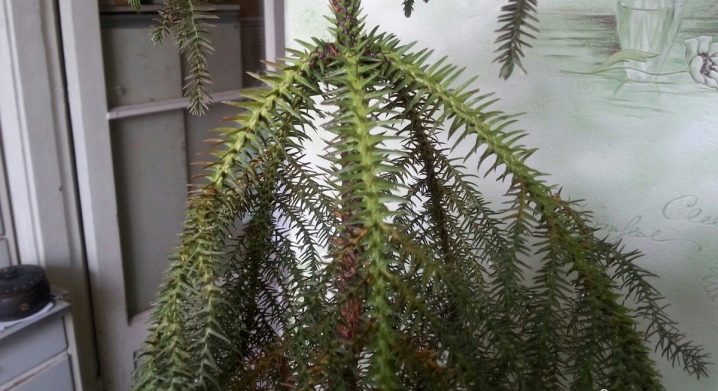

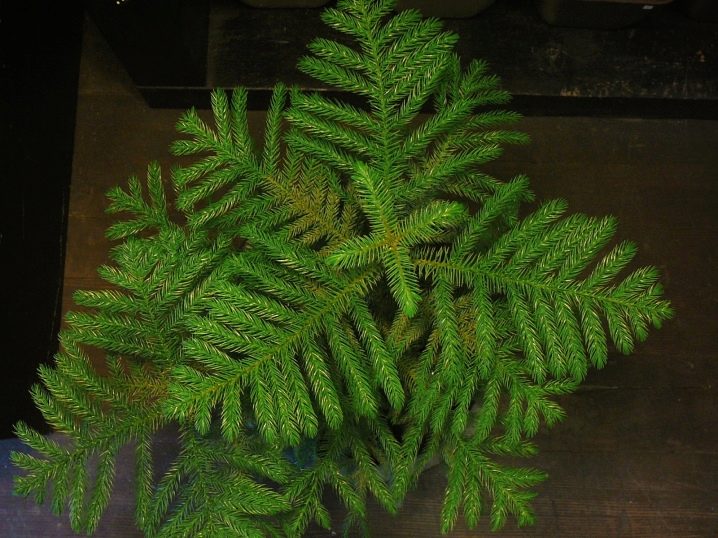
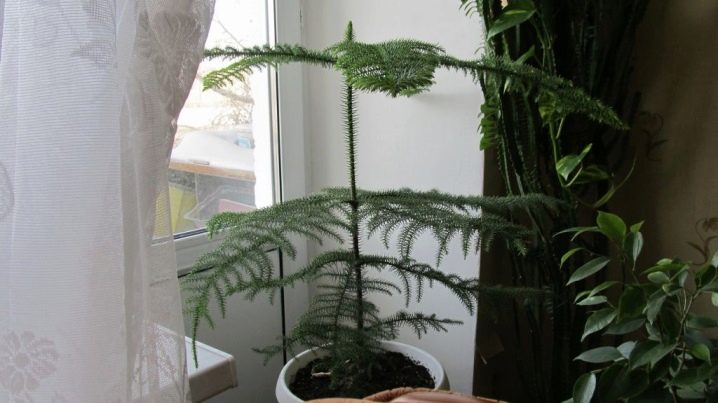
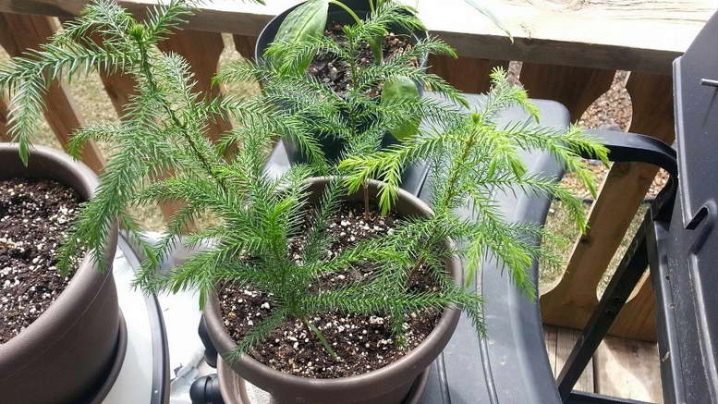
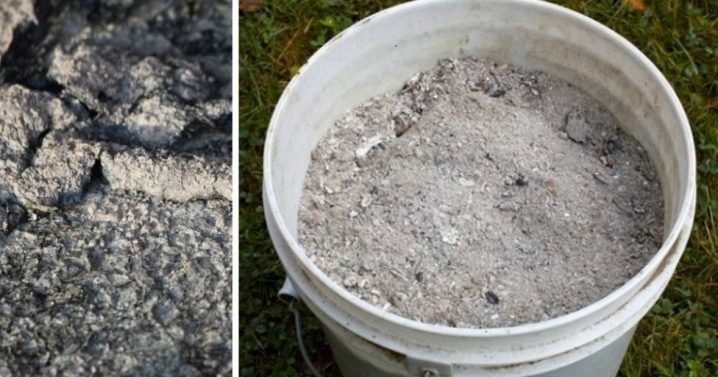

As for pests, they rarely infect araucaria. In rare cases, the appearance of aphids, mealybugs, spider mites and a root beetle that devours wood is observed. If insects are found, it is necessary to immediately wash the plant using a soap or alcohol solution for this, and then treat it with insecticides.

For information on how to care for araucaria at home, see the video below.
Watering features
As for watering, indoor spruce needs soft water. It can be rain or boiled water. A lump of earth in a flowerpot should be constantly wet. Accordingly, the plant needs to be watered frequently in the summer. In winter, when kept in low temperatures, watering is reduced. If you grow araucaria spruce in a pot, then pour expanded clay on a saucer and moisten it constantly. You can cover the soil around the plant with moss or lay out a succulent.How it looks can be seen in the photo. This will help the crop to be constantly replenished with moisture. More details can be seen in the video.
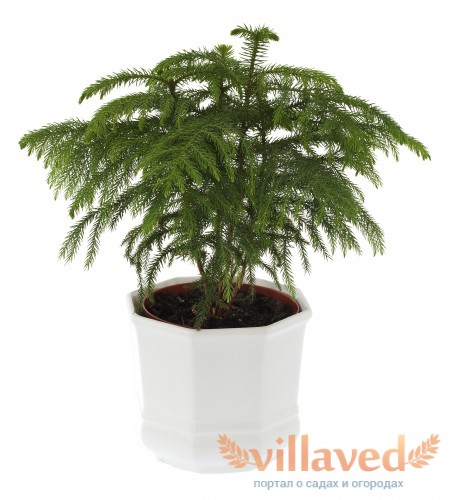
Araucaria in a flowerpot
Please note that indoor araucaria need constant spraying. In summer and winter, this should be done daily.
Ideal if you can maintain a humidity level of 70%. When spraying, succinic acid must be added to the water. In very dry air conditions, the tips of the leaves can dry out and turn yellow. This is the first signal of a lack of moisture. With a lack of moisture, the leaves may fall off.
Reproduction methods
Araucaria reproduces quite well at home. For this, cuttings or the seed method are used.
Cuttings
The procedure is performed in the middle of summer, using the crown of the crown as a planting material. If it is not possible to cut the stalk from the top of the tree, then the use of lateral shoots is allowed. However, many experts believe that it is impossible to grow a tree of the correct shape from them, as from the top. The procedure for propagating araucaria by cuttings is as follows: the shoot you like is cut off from the tree 3-4 cm below the whorl, wipe off the juice that has come out, dry the cut and sprinkle with chopped charcoal. The twig is left in this state for a day, which is usually enough to tighten the wound. Then the cut is treated with heteroauxin or any other root formation stimulator, after which the preparation of the soil substrate is started.

The earthen mixture is purchased in the store or prepared by yourself. For this, sand and peat are taken in equal shares, mixed and watered. Then a cutting is planted in the substrate and covered with a glass jar on top. Every day, the shoot is ventilated, sprayed and moistened. The most optimal temperature is 25 degrees, otherwise the rooting process slows down significantly. If it is possible to organize the bottom heating, it should be used, as this will help to quickly root the shoot.
Seeds
The seed method is more painstaking and time consuming. Sowing is carried out from April to June, using only fresh seeds. The process begins with the preparation of a nutrient substrate made from a mixture of peat, sand, turf and leaf humus, taken in equal proportions. If the last two components could not be found, then a little charcoal is added to the sand and peat, which is pre-crushed. Then the resulting substrate is poured into pots, watered and sowed. After all the seeds are planted, the ground is covered with sphagnum moss and the boxes are removed to a room with a temperature of 18-20 degrees.
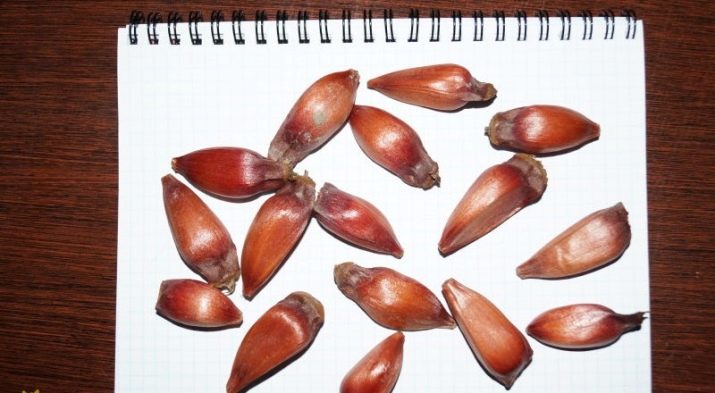
7photos
The seeds germinate very unevenly and some of them may hatch only after 2 months. Seedlings must be protected from direct UV rays, otherwise they will begin to turn yellow and die quickly. It is better to create diffused lighting for them or place them in the shadow of neighboring plants. A pick of young shoots is performed after the first needles appear on them. In the case of single planting of seeds in a pot, the shoots do not dive, but are left in the same containers until the root system gets stronger. After the roots cover the entire ground of the pot, they can be planted in open ground or in a large container.


Views
Araucaria heterophylla or indoor spruce (Araucaria heterophylla). The homeland of the island is Norfolk. These are beautiful majestic trees with a pyramidal crown, reaching up to 60 m in height, with brownish peeling bark. The branches are whorled, branch off horizontally at right angles to the trunk, forming a generally pyramidal crown. Leaves are soft, subulate, slightly curved upward, tetrahedral, small, up to 2 cm long, acicular, light green, densely arranged in a spiral. In culture, it is often confused with another species - Araucaria high (A. excelsa).
This type of araucaria is a widespread houseplant (indoors, especially in cramped pots, plants grow much slower than in nature).
Araucaria angustifolia (Araucaria angustifolia), or Brazilian Araucaria (Araucaria brasiliana). It grows in the mountains of southern Brazil. These are large trees, reaching 50 m in height in nature. The branches of this plant are thin, hanging down. Leaves are linear-lanceolate, up to 5 cm long, bright green. Suitable for growing in rooms, as araucaria rarely grows more than three meters in indoor and greenhouse conditions.
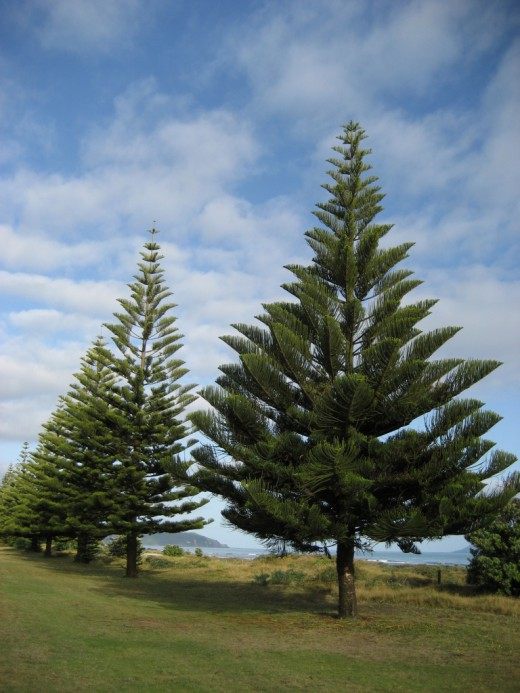 Araucaria heterophylla (Araucaria heterophylla) Kahuroa
Araucaria heterophylla (Araucaria heterophylla) Kahuroa
Columnar araucaria or Cook's araucaria (Araucaria columnaris), common in the southern tropical zone in the New Hebrides and on Pine Island (New Caledonia). The trunks (photo) of these majestic trees are uniformly dressed, from the very base to the top, with a narrow crown, vaguely reminiscent of the crown of a pyramidal cypress. It is formed by relatively short branches, collected in whorls and extending from the trunk almost at right angles (in cypress, the branches are pressed against the trunk). On Pine Island, the columnar araucaria forms dense coastal stands that amazed the first travelers with their appearance, who compared them with basalt columns, or with smoking factory chimneys. At the very top of the tree, the crown is usually slightly widened. Araucaria cones are columnar in shape, up to 10 cm long, have a bristly appearance due to the tops of the scales, drawn into a long (5-6 mm) styloid appendage, which is bent downward.
Chilean araucaria (Araucaria araucana) grows not only in Chile, but also in the western part of Argentina. Chilean araucaria is a very large tree, reaching a height of 60 m with a trunk diameter of up to 1.5 m. The crown of young trees is wide-pyramidal, and its lower branches lie directly on the ground. Lower branches usually fall off with age. The lateral branches of mature trees are 6-7 in whorls, horizontally extended or hanging slightly in older trees; the crown becomes flat-umbellate, located only at the very top of the trunk. The bark is resinous, thick, longitudinally fissured. The leaves of the Chilean araucaria are tough, thorny, dark green, spirally arranged, covering the branches very tightly to each other. Chilean araucaria is photophilous, grows in a humid climate, on uniformly moist, but non-swampy, sufficiently nutrient-rich soils. It also tolerates dry conditions, as well as light frosts. The large seeds of the Chilean araucaria are nutritious and delicious.
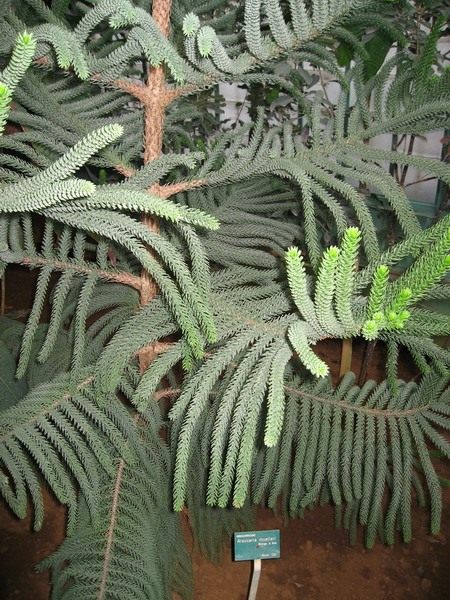 Araucaria (Araucaria Muelleri) Liné1
Araucaria (Araucaria Muelleri) Liné1
Araucaria is a wonderful plant that will delight you and your loved ones! Looking forward to your advice!
Plant transplant
Indoor araucaria does not tolerate a transplant very well - after it it can get sick and even die. Therefore, it is often not worth disturbing the plant, and if it is necessary to transfer it to another pot, observe many conditions:
- the maximum frequency of transplanting adult Christmas trees is once every three to four years,
- manipulations can be performed only from March to mid-May,
- when transplanting, the old earthen lump is preserved as much as possible - it is better to transfer absolutely all the soil from the old one to a new pot,
- the root collar cannot be covered with fresh soil - it should be approximately at the same level as in the previous container,
- large trees more than a meter in height are not transplanted at all - they just pour fresh soil on top or replace the thin top layer of soil with fresh one.
Once transferred to a new pot, Araucaria takes several weeks to adapt. At this time, she needs daily spraying, thorough watering and no direct sunlight. It is better to transfer the flower to a slightly shaded room until it is fully adapted, and then return it to its usual place.
Reproduction
Araucaria can be propagated using cuttings and seeds.Growing from seed is distinguished by its duration and labor intensity:
- For sowing, you need to use only fresh seeds, perennial ones will not work;
- Prepare a container and sow seeds into it, moisten well and cover with moss;
- Place the containers in a warm place where the temperature will not drop below 20 degrees Celsius;
- Be patient, seedlings will not appear quickly, planting needs careful care;
- Avoid direct sunlight on the sprouts, they will very quickly turn yellow, dry and eventually die;
- After the young shoots get stronger and grow a little, the entire planting must be thinned out and about 10 cm of free space left between the plants.
Grown plants are planted in separate containers and further grown in accordance with all the rules.
More details about the tree in the video:
The grafting method is used in the summer season:
- Shoots that have already become stiff are suitable for rooting. It is better to use branches from the top of the plant, if you cannot get them, use side shoots;
- Pick a branch that suits you and cut off half of it. Dry the harvested stalk in the sun and process with crushed coal;
- A mixture of sand and peat is suitable as a soil. Moisten the soil and set a stalk in it for later rooting. Cover the landing with a plastic jar;
- Water periodically and use a spray bottle to moisturize;
- The temperature should be at least 25 degrees Celsius, otherwise rooting will be much slower;
- By the winter period, rooting will be successful and the plants can be planted for permanent residence.
Characteristics of homemade spruce
Araucaria is an evergreen plant. In addition to the listed habitats, it is most common in New Caledonia and Norfolk Island.
About 19 species of plants of this genus are numbered by specialists. They like open free areas near bushes and forests.
In open places, this imposing tree reaches a height of up to 100 meters. A straight, large trunk is decorated with vertical branches with leaves of a needle-like or leathery surface type. In some varieties, the ends of the greens are pointed or resemble an awl. The leaves are located in two versions:
- slightly block each other;
- completely cover the bottom.
The division into masculine and feminine is not always accurate, since the plant changes its sex during growth. Recognize the female origin by spherical cones with a diameter of 5-30 cm located high on the crown. About 200 pieces of edible seeds similar to pine nuts are found in the fruit.
The male gender presupposes the presence of small cones - no more than 10 cm. The shape of such fruits is cylindrical with a diameter of 5-15 cm.
Home care for araucaria
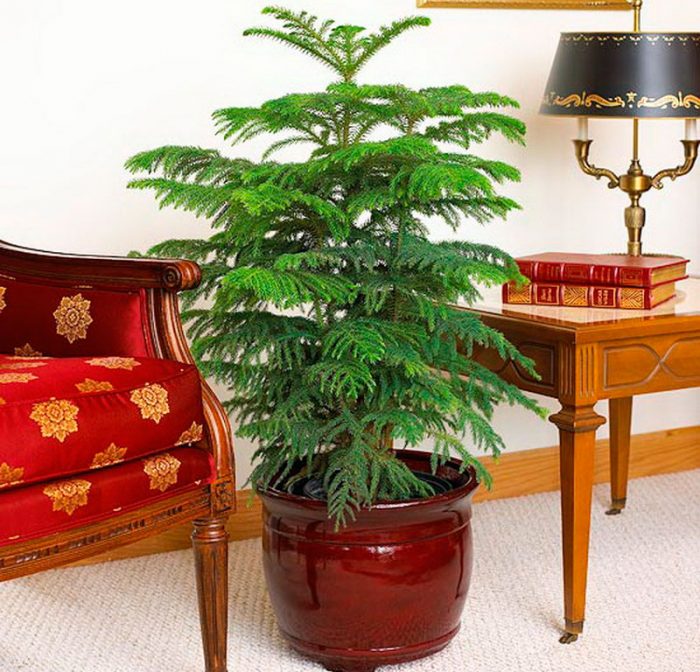
Illumination
Araucaria is a light-loving plant and needs a lot of bright light when grown indoors. However, it must be protected from direct sunlight. In the warm season, if you wish, you can move it outside, and you should choose a place that will be reliably protected from direct sunlight and precipitation.
It is best to put the bush in a place where the light will fall on it from two sides at once. In the event that the light falls on only one side, then in order for the crown to grow and develop evenly, the plant needs to be rotated 90 degrees once every 7 days.
Temperature regime
Indoor araucaria feels good only in the cool. During the summer, the air temperature should be around 20 degrees. In the cold season, it should be about 10 degrees, while the room should not be warmer than 15 degrees.
Watering

Throughout the year, well-settled water is used for irrigation. Make sure that the lump of earth in the pot does not dry out in the summer, as this can damage the plant greatly.In this regard, in the warm season, watering should be systematic and abundant, but liquid stagnation in the root system should not be allowed. In winter, watering should be more scarce and less frequent, especially if the bush hibernates in the cold.
Air humidity
The plant must be regularly moistened from a spray bottle, for this use well-settled water (at least 24 hours) at room temperature. Humidification of foliage is carried out all year round, especially if the araucaria wintering takes place in a room in which there are working heating devices.
Fertilizer
During intensive growth, the plant is fed once every 15 days and a solution of mineral complex fertilizer with a low calcium content is used for this, the concentration of which should be very low. Also, experienced florists recommend feeding it with mullein infusion every 30 days.
Araucaria transplant
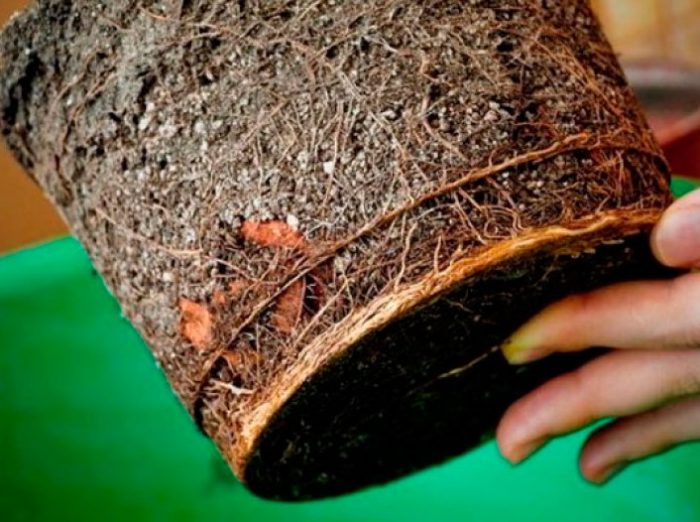
Araucaria transplant is carried out only if necessary after the root system becomes very cramped in the pot. And this procedure is performed in the first half of spring or early summer. This culture does not tolerate transplantation quite well, in this regard, it is recommended to transplant only well-grown bushes.
Transplantation of adult bushes is carried out 1 time in 3 or 4 years, for this they use a wide pot, which is filled with a soil mixture consisting of peat, sod and leafy soil, as well as sand (1: 2: 1: 2). For this, you can also use a soil mixture consisting of sand, humus, peat, coniferous, deciduous and soddy soil, which are taken in equal parts. Do not forget to make a drainage layer at the bottom of the container, which will not allow water to stagnate in the substrate. Araucaria can be grown hydroponically if desired.

